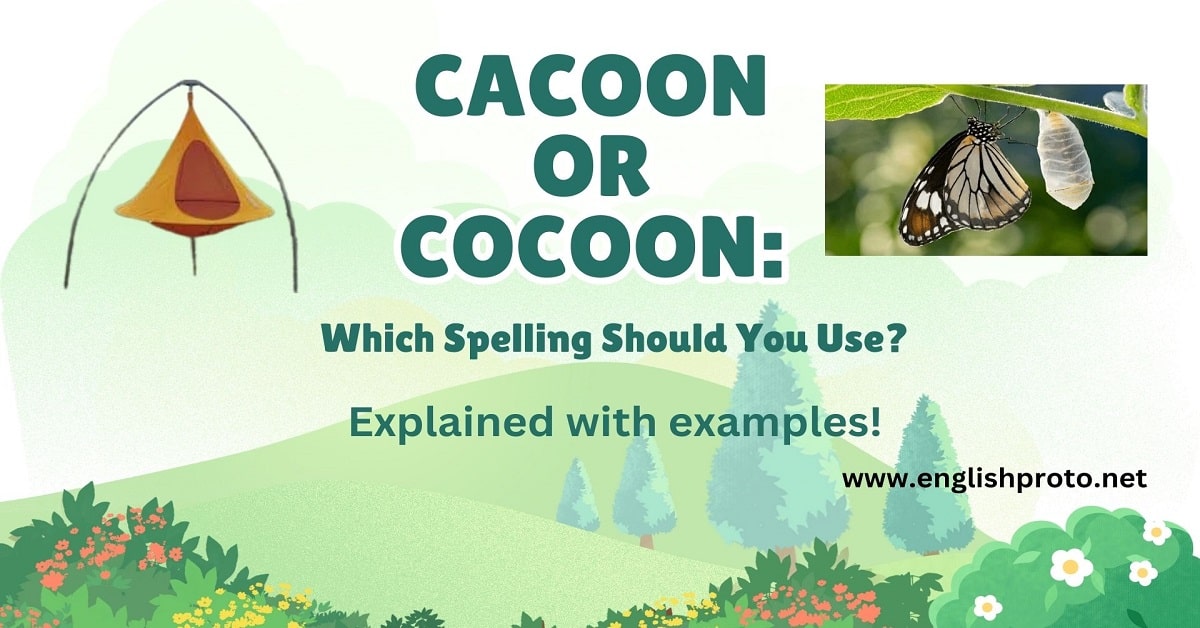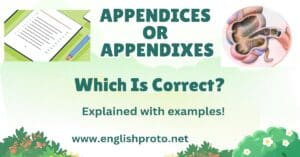Cacoon or Cocoon: ever wondered which is the right spelling? If you’ve ever found yourself hesitating between these two, you’re not alone!
It’s a common mistake, and understanding the difference can make your writing shine. Whether you’re a student, professional, or language enthusiast, this is one of those small errors that can make a big impact on your credibility.
In this article, we’ll clear up the confusion once and for all, breaking down the correct usage and meaning of “cocoon.” Stick around as we dive into everything you need to know, complete with tips and examples that’ll make sure you never misspell it again!
⚡ Quick Summary
- Cocoon is the correct spelling.
- A cocoon is a protective casing made by certain insects, especially caterpillars, as they transition from larvae to adult forms.
- Cacoon is a common misspelling and should be avoided in formal and informal writing.
Key Takeaways:
- The correct spelling is cocoon.
- Cocoon refers to a protective covering made by certain insects, or metaphorically, a safe and isolated environment.
- Cacoon is an incorrect spelling and is often a result of mispronunciation or confusion with other similar words.
Reasons for Confusion
There are several reasons why people commonly mix up the words “cocoon” and “cacoon,” and understanding these can help prevent future errors.
1. Phonetic Similarity
The biggest reason for confusion between these two words is how they sound when spoken. The word cocoon is pronounced with a long “o” sound, much like the “oo” in “moon” or “balloon.” However, because the “c” and “k” sounds are both soft and occur near each other, it’s easy for speakers to mishear or mistype “cocoon” as “cacoon.”
2. Influence of Other Words
English contains many words ending in “oon” that sound similar to “cocoon,” such as “balloon,” “buffoon,” and “raccoon.” The suffix “-oon” appears frequently in English, and the spelling of these other words may cause people to assume that “cacoon” is a legitimate alternative spelling of “cocoon.”
3. Regional Dialects and Variations
In some English-speaking regions, especially with certain accents, the distinction between “c” and “k” sounds may not be as pronounced. As a result, native speakers of those dialects might misspell “cocoon” as “cacoon,” thinking it is the correct form.
While these reasons explain why cacoon might be used, it’s important to emphasize that cocoon is the correct spelling. Using the right spelling not only enhances your credibility but also ensures that you communicate your ideas clearly.
Detailed Explanation of the Correct Usage
The correct word, cocoon, is used to describe a specific biological process in the insect world, but it also has metaphorical meanings in a broader context. Let’s break down the term’s meaning, usage, and the different scenarios where it can be applied.
1. Biological Meaning:
The primary meaning of cocoon refers to the protective case created by certain insects, such as caterpillars, during their metamorphosis. The process of cocoon formation is part of the insect’s lifecycle, where it wraps itself in a silken case to undergo the transformation from larvae to adult.
- Example 1: “The caterpillar spins a delicate cocoon around itself before turning into a butterfly.”
- Example 2: “In nature, the cocoon is the insect’s way of staying safe while it transforms.”
2. Figurative Meaning:
Over time, the word “cocoon” has taken on a figurative meaning. It is often used to describe a safe, isolated, or protected environment, typically one in which someone is shielded from external challenges or stresses. This could refer to a physical space, such as a room, or a mental state.
- Example 1: “During the winter months, she prefers to cocoon in her cozy apartment, avoiding the harsh weather outside.”
- Example 2: “After the stressful event, he cocooned himself in his work, avoiding social interactions.”
Using cocoon in this figurative sense conveys a sense of safety and comfort, suggesting that the individual is protecting themselves from outside influences, much like a caterpillar protected within its cocoon.
Common Errors
While “cocoon” is the correct term, it’s easy to make mistakes, especially when writing quickly or under pressure. Here are some common errors to avoid:
| Incorrect Usage | Explanation |
| Cacoon | This is a misspelling. The correct word is “cocoon,” with only one “c.” |
| Cocooned (verb) | Using “cacooned” as a verb is incorrect. The proper form of the verb is “cocooned,” meaning “to enclose or wrap in a cocoon.” |
| Cocooning (incorrect meaning) | While “cocooning” is a valid term in some contexts, using it to mean “to isolate inappropriately” can confuse readers. Stick to the metaphorical meanings unless it’s about the insect life cycle. |
Using cacoon instead of cocoon might lead to confusion or make your writing seem unpolished. Correct spelling enhances the professionalism of your work and prevents unnecessary misunderstandings.
Synonyms or Alternatives
Although cocoon has a unique meaning, there are other words you can use as synonyms, especially in a figurative sense:
- Chrysalis: This term refers specifically to the pupal stage of a butterfly or moth, while the insect is inside its cocoon. This can be used when you need to be more precise about the stage of metamorphosis.
- Example: “The butterfly emerged from its chrysalis after several weeks.”
- Shell: In certain contexts, shell can be used to describe a protective covering, whether literal or figurative. It works well in non-entomological situations.
- Example: “The seed remained in its shell, safe from predators.”
- Sanctuary or Refuge: These words can also metaphorically describe a safe or protected space where someone feels sheltered from the outside world.
- Example: “The library was her sanctuary, where she could escape the chaos of the world.”
Each of these alternatives can convey a sense of protection, but cocoon specifically carries the imagery of transformation or change, making it a unique choice for some situations.
Examples in Sentences
Here are a few more examples to show how cocoon can be used in different contexts:
1. Literal Context:
- “After days of spinning silk, the caterpillar finally formed a perfect cocoon.”
- “The cocoon was an essential part of the caterpillar’s metamorphosis into a butterfly.”
2. Figurative Context:
- “After the breakup, she cocooned herself in her apartment, avoiding social gatherings.”
- “His mind was like a cocoon, filled with ideas, waiting to break free and blossom into something new.”
Origins and History
The word cocoon comes from the French word “cocon,” meaning “egg” or “small case.” The first use of cocoon in English can be traced back to the 17th century.
The term referred to the protective silk casing spun by insects, particularly moths and caterpillars. Over time, it developed a figurative meaning to describe any enclosed or protected environment.
The cocoon process is fascinating in itself, as it marks a crucial stage in an insect’s life cycle. The transformation within the cocoon is one of the most remarkable natural phenomena, symbolizing change, growth, and rebirth, which may explain its adoption as a metaphor in language.
Conclusion
The confusion between “cacoon” and cocoon is understandable, but the correct spelling is clear: cocoon. Whether you’re describing an insect’s protective case or using the term figuratively to convey safety and transformation, it’s essential to use the correct form to maintain clarity and professionalism in your writing.
By following the guidelines and examples provided, you can confidently use cocoon in your writing, avoiding the common error of “cacoon.” Proper spelling ensures that your communication is accurate, and it also demonstrates your attention to detail, an important trait in both academic and professional settings.
Remember, when in doubt, cocoon is the right choice. And now that you know the difference, you’ll never have to second-guess the spelling again!



